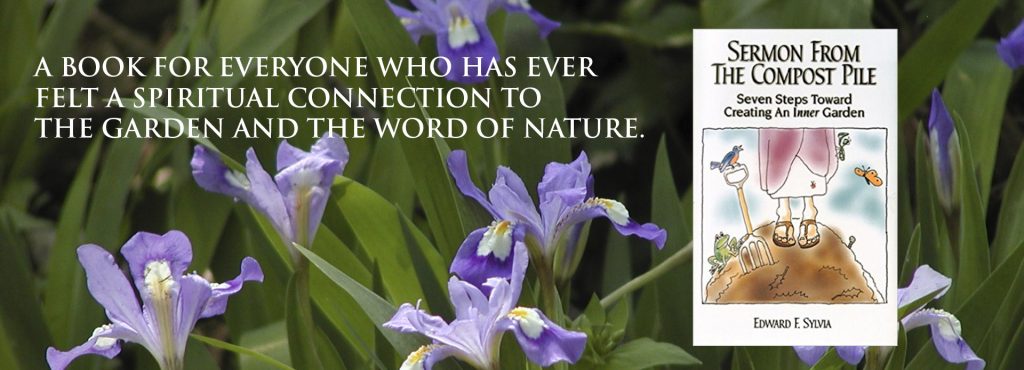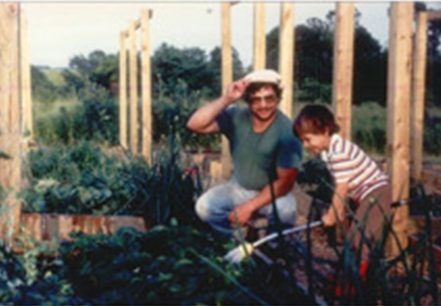
EXCERPT: sermon from the compost pile
seven steps toward creating an inner garden

INTRODUCTION
We all exist in two worlds—one visible, the other invisible. Whether you call it the soul, spirit, the subconscious, or the mind, we all have a private little world. This world is just as important as the outer world. In fact, our inner world is even more important,* because it colors our view of the outer world, such as a farmer thanking God for a rainstorm, while a city dweller curses the rain for ruining the weekend plans.
We would not be able to lie, deceive others, or be a hypocrite, unless we could function under a dual dynamic and have the ability to separate outer appearance from our inner reality. When we observe co-workers kissing-up to the boss or politicians kissing babies, our suspicions are roused. We suspect such people as having a hidden agenda, or some other ulterior motive, because we have all learned how to keep up appearances, e.g., “When in Rome, do as the Romans do. Through the years, we have even invented sayings to help keep us wary of mere outer appearances like, “You can’t always judge a book by its cover,” and “Beauty is only skin deep.”
Perhaps the most salient words ever uttered to present this duality of worlds for our edification were “White man speak with forked tongue.”
In the works of literature or film, this duality of character is designated as the text and the subtext. The text involves what a particular character is literally saying, while the subtext consists all the clues a reader or the audience is being given to reveal what the character really intends.

“Gardening lets you accomplish much more than simply restoring ecological balance to your small patch of ground. The peace and order of a garden brings peace and order to the human mind.”
REVIEWS
Are you searching for eternal happiness?
According to Edward F. Sylvia, you will unearth it in the garden—your “inner garden.” It never occurred to me to compare my spiritual development to the growth that takes place in an actual garden. But Sylvia presents such obvious parallels between the two that, since I read his book, it is impossible for me to labor in my own back yard vegetable patch without remembering his observations. He separates the quest for a joyous life into seven steps with each one having a designated chapter.
All the steps collect into a final lesson: a process is required to create happiness. Again, do gardens suddenly appear out of the soil with no effort? Of course they don’t and Sylvia does not skip around this definite conclusion. “True success is a magical state in which our energies flow freely to meet the task at hand. It is not the absence of work or the absence of a worthy challenge, but the perfecting of our God-given abilities to unselfishly meet these challenges,” he writes. “Living is doing, not getting.”
Adding a private touch to the book, he includes pictures of himself and his family working in their garden and enjoying life on their farm. I took pleasure in seeing people smile while performing manual labor. I reailzed he applies these lessons to his own life.
– annalee allen, lexington, sc, ©2002 the dispatch
An insightful book with a message of hope and refinement for the soul, written especially for garden lovers but filled with wisdom for all who seek to open their inner selves to a higher plane of existence, Sermon From The Compost Pile is recommended as a welcome and appreciated contribution to self-help, self-improvement reading lists, and will have a special affinity for students of spirituality as well as those having a penchant for gardening.
– midwest book review
This is one of those timeless books—one that is almost beyond classification. I first saw a copy at the London Book Fair and was imediately drawn to it in a way that I find difficult to explain. Only later, when a review copy was sent to me did I discover that the ideas the author so charmingly presents, stem in the first place from the writings of Emanuel Swedenborg, whom T. D. Suzuki called “the Buddha of the North.”
The aim of the book is to take us on a journey through “the gardens of the spirit,” and to see ourselves as caretakers of our own mental and spiritual processes. These the author relates to a wholistically environmental process of “inner gardening,” while also giving many useful tips—which he has proven in his own gardening llife—for improving and harmonising our external gardens, however large or small they might be.
Anyone who has an insight into the spiritual world of the garden will find a resonance with this book. And those who do not have this experience may find that it opens new doorways for them.
– pure land notes, devon, england
